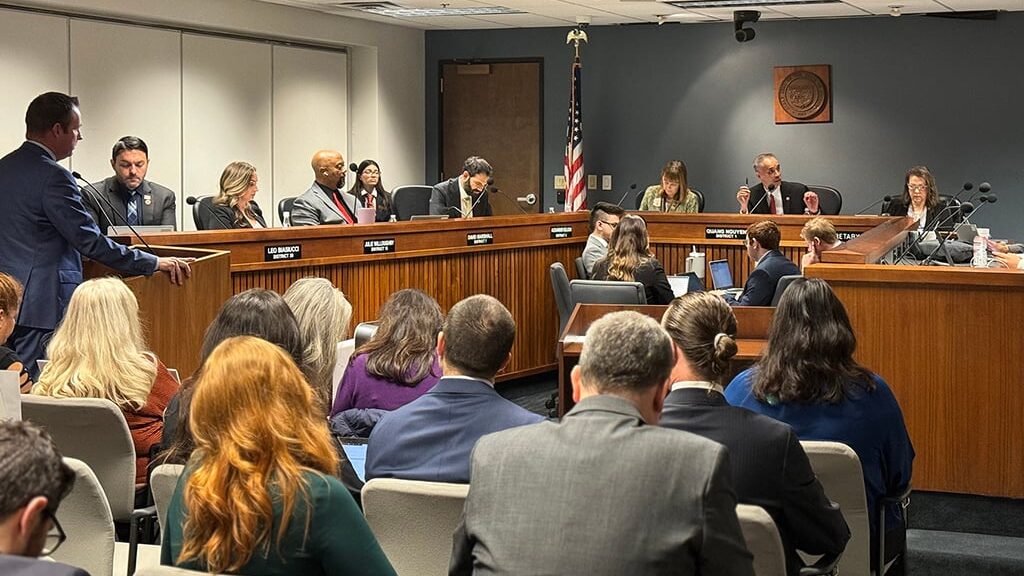Phoenix company ElectraTect creating marijuana Breathalyzer to detect consumption
May 4, 2023, 4:05 AM

Evan Darzi, co-founder and CEO of ElectraTect, writes the molecular compound for Delta-9 THC on April 25, 2023, in Phoenix. (Photo by Mia Andrea/Cronkite News)
(Photo by Mia Andrea/Cronkite News)
PHOENIX – Scientists at Phoenix-based company ElectraTect are working to create a marijuana Breathalyzer to detect recent consumption of THC — the major psychoactive component in marijuana.
As marijuana decriminalization spreads across the country, the market for the plant has flourished, along with a need for technology that can detect THC impairment.
Currently, marijuana is completely banned in only three states; 38 states, three territories and the District of Columbia allow medical use of cannabis products, and more than 20 states allow recreational use for adults, according to the National Conference of State Legislatures.
“I think especially in states where it’s legalized, we do need a device that can detect whether someone is impaired,” said Kayla Merker, research assistant for ElectraTect.
ElectraTect was founded in 2020 after CEO Evan Darzi and co-founder Neil K. Garg decided to create a company that would focus on the detection of THC, based on their prior work at UCLA.
Darzi, who was born and raised in Arizona, earned his bachelor’s and master’s degrees from Arizona State University in medicinal biochemistry. After getting his doctorate from the University of Oregon in 2016, he received a National Institutes of Health grant to work as an organic chemist at UCLA.
After working together, Garg and Darzi realized there’s a greater need for the general public to understand the importance of science in everyday problem-solving.
“I think when people hear about chemistry or science, they kind of shudder and don’t like to think about it,” Darzi said. “So we really wanted to do what we could to sort of bridge that gap. So we did a lot of outreach, including this whole series of organic chemistry coloring books — some are good for kids, and some are good for adults. But what Professor Garg also did was, he would give lectures in public spaces talking about very simple fundamental chemistry discoveries that led to technologies that we use every day.”
In these lectures, Garg would include examples, one of which was the well-known Breathalyzer.
After an audience member asked why there wasn’t such technology for marijuana yet, Darzi said, “We came back to the lab and asked a bunch of the researchers there, ‘Hey, let’s look into this and see why there isn’t any technology like this.’”
The initial hurdle: At the federal level, marijuana is still considered an illegal Schedule 1 controlled substance — along with heroin, meth and LSD. Obtaining a Drug Enforcement Administration license took a year of paperwork, calls, emails and security, just to be able to conduct research. Then, they tackled the challenge of converting fundamental chemistry into something that could eventually be used in a handheld device.
“If we look at the molecular structure of alcohol versus THC, alcohol has two carbons and an oxygen. What that little Breathalyzer is doing is actually taking away these two little hydrogens in a process called oxidation,” Darzi said. “If you want to do that on THC, there’s a lot more places where that can happen. There’s a much more complicated structure.”
Darzi and Garg published a paper about the idea that gathered a lot of interest from donors and investors, leading them to start ElectraTect. Currently, the company has six full-time employees in an office/laboratory space in a building on ASU’s downtown Phoenix campus.
Overall, the need for a Breathalyzer stems from the fact that current testing detects marijuana usage over days rather than recent use that is more closely linked to impairment.
“We don’t have technology that’s really capable of testing for THC, especially recent THC. So somewhere like Arizona, you can get pulled over, and we’re still using old-school testing technology that can’t really tell you recently” whether someone used THC, Darzi said. “But you can still get prosecuted, and you can still be denied the right to work. So we’re trying to really use our technology to build a more fair system for testing.”
Thomas Marcotte, co-director of the Center for Medicinal Cannabis Research at the University of California, San Diego, has been conducting cannabis clinical trials for more than two decades and is currently the principal investigator on studies addressing the effects of cannabis on driving performance.
“THC concentrations in blood spike very quickly, and then it very quickly distributes to other parts of the body. So within an hour, the amount of THC detectable in blood is very low,” Marcotte explained. “A person can still be impaired with these low blood concentrations; it is what is happening in their brain, not the blood.”
Marcotte said that regular marijuana users can also have low levels of THC in their blood hours and days after use, and that in the case of traffic safety, it can take hours after a blood draw to test the blood, leading to low concentrations.
Unlike alcohol, Marcotte said there is currently no biological method to determine a legal limit for THC above which an individual can be called impaired.
“With respect to driving, at this point the best approach is for law enforcement to take into consideration the ‘totality of the evidence’ — driving behavior, driver interviews and field sobriety tests,” Marcotte said in an email.
While current technology, which detects marijuana usage through blood or urine samples, is not yet refined enough to work like a Breathalyzer, ElectraTect is focused on what scientists there call the “peak impairment window.”
“There are clinical trials that show that there are trace amounts of THC on breath that are present between three to six hours after usage,” ElectraTect Senior Scientist Christina Forbes said. “We want to be able to capture that timeframe, which would correlate most with the peak impairment window, which is what we’ve been calling it.”
Forbes, who joined the company in May 2021, believes the product will benefit the public in many ways, especially in regard to public safety.
“We know from Colorado, once cannabis legislation passed — especially for recreational (use) — there was an increase in incidents of people … impaired due to THC while driving, leading to a number of traffic fatalities,” Forbes said. “It’s a big problem, and we’ve seen that growing nationwide. These are people legally using a product, but they’re not actually being responsible, because they don’t know their own impairment levels.”
Madeline Meier, associate professor of psychology at Arizona State University, has researched the effects of cannabis use on cognitive function and mental and physical health. According to Meier, THC is fat-soluble, which means it’s absorbed into fat tissue and is gradually released into the bloodstream, which can show a positive blood or urine test for THC, even if the user has not used cannabis recently.
Meier agrees a marijuana Breathalyzer is needed.
“This product is potentially very important,” Meier said. “Now that medical and non-medical cannabis use are legal in Canada and in many states in the U.S., it is critical to have accurate measures of recent cannabis use. Accurate measures could, for example, aid in exonerating drivers who are not impaired but show a positive blood test because they used cannabis yesterday.”
Meier said additional research is needed to find the most accurate tests of impairment and breath or blood cutoffs that reflect impairment.
Darzi said ElectraTect plans to market its Breathalyzer to medical marijuana users first, but they will eventually offer the device to law enforcement.
“We don’t want to discourage people from using cannabis products to treat their pain because they’re worried they might lose their job,” Darzi said. “We also want to know what level of THC impairment is unsafe to drive or operate heavy machinery. It’s very likely there’s some low dose that can give you some pain relief, but is not going to exceed that threshold.”
Meanwhile, lots of questions remain, and competition is looming. California-based Hound Labs and Canadian firm Cannabix Technologies have also developed marijuana Breathalyzers. Darzi said that what makes ElectraTect different is its approach.
“Each company is going about approaching and solving this product a little differently, but what sets ElectraTect apart from the others is our approach uses fuel-cell technology, which is something already widely used in a variety of other applications, such as alcohol Breathalyzers,” Darzi said.
According to ElectraTect, it is too early to say what the exact cost of the product would be, but the company is ideally shooting for a price range similar to alcohol Breathalyzers that are on the market for private consumers.
Forbes said ElectraTect plans to have the product available to the market in the next two to four years.









